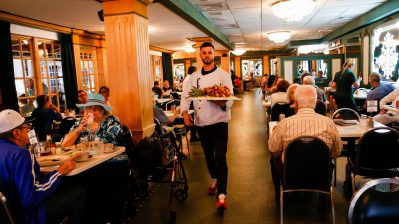The pros and cons of restaurant tipping
Andrew Hoffman wants to end tipping as we know it. And he is not alone.
Hoffman is co-owner of Comal, a modern Mexican restaurant in Berkeley, California. “I think tipping is an unhealthy practice,” he said. “I would be in favor of anything that got restaurants out of that model.”
Hoffman said tipping creates all kinds of problems, like encouraging waiters to fight for tables instead of working together. He said it also creates inequality in the restaurant because waiters can earn much more than kitchen staff and managers who do not get tips.
By law, tips go directly to waiters. So about a year ago, Hoffman replaced tips with a 20 percent service charge. With the service charge, the restaurant gets the money and can do whatever it wants with it. Hoffman uses the service charge to balance out pay between waiters and kitchen staff, he said.
What pushed Hoffman to finally get rid of tips was rising minimum wage. It is increasing in California, and as it does, restaurants have to pay everyone more, including waitstaff. California is one of a handful of states where waiters get tips on top of full minimum wage, which in Berkeley is now $11 an hour. Hoffman said the service charge would give him more financial flexibility as wages continue to increase.
Restaurant owners in other cities with rising wages are also ditching tips and citing labor costs as the primary motive. All this scares career waiters like Kim Schooling. “We have no idea what our income could potentially look like if this shift takes place,” she said.
Schooling has waited tables in The Bay Area for 20 years. She feels as if restaurant owners are using rising minimum wages as an excuse to get their hands on tips, and that over time waiters will make less and less income. “It seems oddly opportunistic,” Schooling said. “Like, ‘Oh, our back is up against the wall with the wage increases, so we’ll use this income.’”
At a few restaurants the no-tip experiment has backfired so badly owners have had to reinstate tips to keep waiters from quitting. Hoffman worried about that at his restaurant. So he is chipping in to make sure no one takes a pay cut.
That pleased staffers like Sedric Pieretti. He bartends at Hoffman’s restaurant, and said he now prefers the no-tip model.
“I think the only drawback is it limits your ability to commit tax fraud,” he said. Jokes aside, Pieretti said he prefers to have his boss, not his customers, decide his compensation. But if service jobs started paying considerably less, Pieretti added, he might have to look for a new career.
There’s a lot happening in the world. Through it all, Marketplace is here for you.
You rely on Marketplace to break down the world’s events and tell you how it affects you in a fact-based, approachable way. We rely on your financial support to keep making that possible.
Your donation today powers the independent journalism that you rely on. For just $5/month, you can help sustain Marketplace so we can keep reporting on the things that matter to you.


















